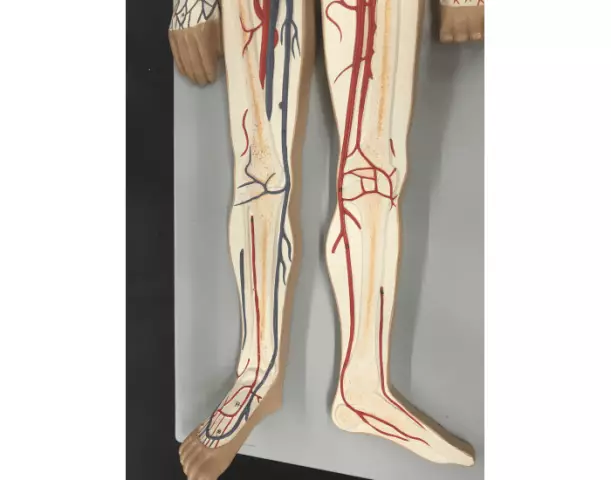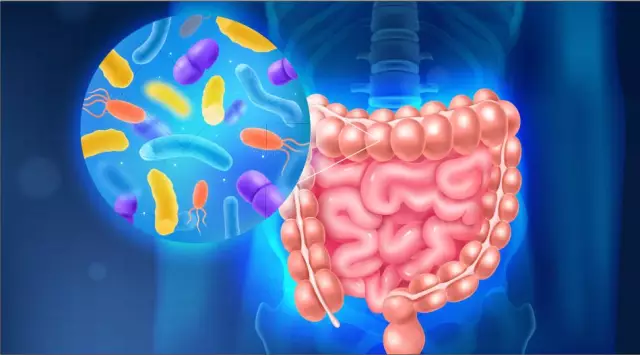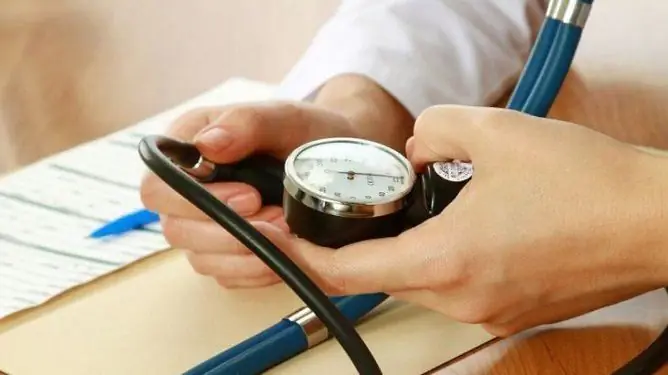- Author Rachel Wainwright [email protected].
- Public 2023-12-15 07:39.
- Last modified 2025-11-02 20:14.
Circulatory disorders of the lower extremities

For the normal functioning of any human body, oxygen is needed. It enters organs and tissues from the blood. Therefore, in order for the body to function normally, full blood circulation is necessary.
If the structure or function of the arteries or veins of the legs is impaired, blood circulation in the lower extremities is impaired.
Causes of circulatory disorders of the lower extremities
The main causes of circulatory disorders can be divided into 2 groups: arterial and venous.
Venous:
1. Varicose veins.
Veins do not have a muscle wall, so they cannot contract. However, the blood, overcoming the natural force of gravity, strives upward to the heart. This is due to many factors. One of them is the presence of special valves in the communicative (connecting) veins. It is they who do not allow the reverse flow of blood from superficial veins into deep ones. From deep veins, blood rises higher for the following reasons:
- Blood pressure from arteries.
- The work of the leg muscles. Muscles, figuratively speaking, act as pumps, contracting and unclenching. When they contract, they push blood out of deep veins. When muscles are relaxed, movement is maintained only by the pressure of blood from the arteries.
- The presence of a valve apparatus.
Under unfavorable conditions, the veins can become less elastic, the valves atrophy, and varicose veins occur, and then, as a symptom, a violation of the venous circulation of the lower extremities.
There are many reasons for varicose veins: upright walking, genetic predisposition, hormonal disorders, diseases of the nervous system. Lifestyle plays an important role: low mobility, sedentary or standing work, long-term stay in one position.
2. Thrombophlebitis.
Thrombophlebitis is an inflammation of the altered vein wall in the presence of a blood clot in it. Therefore, this disease in some cases is a complication of varicose veins of the lower extremities.
Thrombophlebitis inflammation is aseptic, i.e. proceeds without the participation of microbes.
Most often, patients with thrombophlebitis already have quite serious diseases that have led to impaired circulation of the lower extremities and thrombophlebitis. These are patients with chronic heart failure, serious endocrinological problems, oncology, etc.
Depending on the size of the thrombus, the lumen of the vein can be closed completely or partially. Partial closure of the lumen of the vein leads to the formation of a chronic violation of the venous circulation of the lower extremities.
Diseases of the arteries leading to poor circulation in the lower extremities:
1. Obliterating atherosclerosis of the great vessels of the lower extremities. This disease affects mainly men over 40-45 years old. Obliterating atherosclerosis is a chronic disease, long-term and leading to severe circulatory disorders. Arteries of medium (popliteal, femoral) and large caliber are affected more often.
Obliterating atherosclerosis is a manifestation of systemic atherosclerosis. With this disease, changes are localized in the inner lining of the arteries. Cholesterol is deposited in it and a fatty plaque is formed. At the initial stage, this process is reversible. The lumen of the vessel narrows, and signs of circulatory disorders of the lower extremities gradually begin to appear. As the plaque grows, the clinical picture of circulatory disorders is aggravated.
From a large atherosclerotic plaque, pieces can eventually break off and enter the underlying arteries. Since they have a smaller diameter, the thrombus can get stuck, cause an acute lack of blood supply and lead to gangrene.
2. Obliterating endarteritis (thromboangiitis) is a chronic systemic inflammatory disease that affects the small arteries of the lower extremities. Until now, the exact cause of the disease has not been established. There are several main theories of the occurrence of obliterating endarteritis:
- infectious toxic (provocateur - infectious agent);
- pathology of the blood coagulation system;
- allergic (allergic reaction to tobacco);
- atherosclerotic.
3. Diabetic angiopathy. Diabetes mellitus is a risk factor for cardiovascular disease. The lesion can be in the nature of macro- or microangiopathy. Over time, impaired blood circulation in the lower extremities leads to necrosis of the most distant areas: the tips of the toes, then the lower leg, etc. Diabetic angiopathy is aggravated by the fact that patients of this group only in rare cases do not have concomitant atherosclerosis obliterans or cardiovascular insufficiency. In most cases, there is a combined pathology, and, consequently, circulatory disorders progresses quite quickly.
Risk factors leading to the development of circulatory disorders of the lower extremities
- diabetes;
- smoking;
- increased cholesterol levels and lipid imbalance;
- high blood pressure;
- increased homocysteine levels;
- obesity of 1 or more degrees;
- sedentary lifestyle, etc.
Symptoms

The main symptoms depend on the degree of circulatory disorders.
In the initial stages, the patient may experience moderate discomfort or pain after relatively little physical activity. As the circulatory disorders of the lower extremities progress, the symptoms become more pronounced. The pain intensifies, a characteristic symptom appears - intermittent claudication. It refers to pain or severe discomfort in the lower extremities that occurs when walking and disappears when you stop. The degree of circulatory disturbance is determined by how far a person can walk before the onset of intermittent claudication.
As the progression progresses, there are violations of the trophism of the skin: they become pale, dry, trophic ulcers may appear. With an advanced process, gangrene sets in.
Treatment of circulatory disorders of the lower extremities
There is no single treatment regimen for circulatory disorders. This is due to the fact that there is no diagnosis as such: “circulatory disorders of the lower extremities”. This is a symptom that is a sign of a disease.
If the violation of the venous circulation of the lower extremities is caused by varicose veins, then it is necessary to treat it.
If the cause is atherosclerosis obliterans, then it is always necessary to adjust the diet to normalize the level of total cholesterol and other lipids.
In addition to specialized treatment, there are always general recommendations, observing which you can slow down the progression of circulatory disorders of the lower extremities. First of all, it is quitting smoking. This also includes keeping an active lifestyle. The risk of developing cardiovascular pathology increases sharply if a person walks less than 12 km per week.
The complex treatment of circulatory disorders of the lower extremities always includes physiotherapy exercises and physiotherapy.
YouTube video related to the article:
The information is generalized and provided for informational purposes only. At the first sign of illness, see your doctor. Self-medication is hazardous to health!






